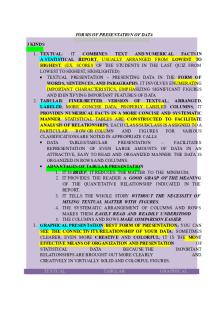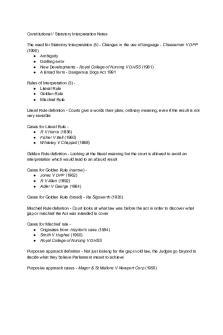Module 23 Notes - Visual Organization and Interpretation - Appsych PDF

| Title | Module 23 Notes - Visual Organization and Interpretation - Appsych |
|---|---|
| Author | 葉yay yh |
| Course | AP Psychology |
| Institution | 연세대학교 |
| Pages | 3 |
| File Size | 68.8 KB |
| File Type | |
| Total Downloads | 19 |
| Total Views | 124 |
Summary
Visual Organization and Interpretation Visual Organization and Interpretation Visual Organization and Interpretation...
Description
Module 23: Visual Organization and Interpretation To Learn: ✵ Gestalt psychologists’ understanding of perceptual organization ✵ How figure-ground and grouping principles contribute to our perceptions ✵ Binocular and monocular cues to perceive the world in three dimensions
✵ Discuss how perceive motion ✵ Perceptual constancies help us construct meaningful perceptions ✵ Research on restored vision, sensory restriction, and perceptual adaptation reveals about effects of experience on perception
Perceptual Organization ♠ ♠ ♠
German psychologists noticed people given a cluster of sensations tend to organize them into a gestalt ♦ Gestalt: German word meaning “whole” or “form” Conscious perception is a seamless scene — integrated whole Necker Cube = example of Gestalt psychology ♦ Perception is more than just sum of a stimuli’s parts ♦ Perception is constructive process: ♣ Filter incoming info and construct the perception
Form Perception ♠ ♠
Figure and ground: organization of the visual field into objects (the figures) that stand out from surroundings (the ground) ♦ First perceptual task brain must complete → determine the figure from ground Grouping: rules in brain creates starting in infancy ♦ Help create order and form to stimuli we sense ♦ Proximity: group nearby figure together ♦ Continuity: perceive smooth continuous patterns ♣ Not discontinuous ones ♦ Closure: fill in gaps to create a complete, whole object ♦ Similarly:
Depth Perception ♠
♠
♠
♠
Depth perception: ability to see objects in three dimensions ♦ Images that strike retina are two-dimensional ♦ Judge distance Visual cliff: Eleanor Gibson and Richard Walk (1960) designed a series of experiments in Cornell University laboratory using visual cliff ♦ Model of a cliff with a “drop-off” area that was actually covered by sturdy glass ♣ Tested on 6-14 month old infants ♣ Most infants refused → they could perceive depth Binocular cues ♦ Depth cues, such as retinal disparity and convergence ♦ Depend on the use of two eyes ♣ ex) both eyes open, hold two pens or pencils in front and touch tips; try with one eye closed ♦ To judge distance of nearby objects ♦ Convergence: inward angle of eyes focusing on a near object ♦ Retinal disparity: comparing retinal images from the two eyes → brain computes distance ♣ Greater disparity / difference between two images, closer the object Monocular cues ♦ Depth cues requiring only one eye, helpful for judging farther distances ♣ Relative height: perceive objects higher in field of vision as farther away
♣ ♣
♣ ♣ ♣
Relative size: if assume two objects similar in size, most people perceive on that casts the smaller retinal image as farther away Relative motion: when moving, objects that actually stable may appear to move ♥ Riding on bus and fix gaze on some point, objects beyond fixation point will appear to move along ♥ Objects in front of point appear move backward ♥ Farther an object from fixation point, faster seem to move Interposition: if one object partially blocks view of another, perceive as closer Linear perspective: parallel lines appear to meet in distance ♥ Sharper convergence = greater perceived distance Light and shadow: shading produces a sense of depth constituent with assumption that light comes from above
Motion Perception ♠ ♠ ♠
Motion perception isn’t perfect ♦ Large and small objects move at same speed, large objects appear to move more slowly Stroboscopic movement: brain perceives a rapid series of slightly varying images as continuous movement Phi phenomenon: perceive two adjacent stationary lights blinking on and off in quick succession as one single light moving back and forth
Perceptual Constancy ♠ ♠ ♠ ♠ ♠ ♠
Perceptual constancy: top-down process recognizes objects without being deceived by changes in color, brightness, shape, or size Color constancy: perceiving familiar objects as having consistent color, even if changing illumination alters wavelengths reflected by object Brightness constancy: perceive object as having constant brightness even as its illumination varies ♦ Depends on relative luminance: amount of light an object reflects relative to its surroundings Shape constancy: perceive object as having unchanging shape, even while distance from it varies Size constancy: perceive object as having unchanging size, even while distance from it varies Moon illusion: moon looks 50% larger when near the horizon than high in sky
Ames Room ♠
A distorted room (designed by Adelbert Ames) appears have normal rectangular shape when viewed through a peephole with one eye ♦ Girl in right corner appears larger than left because false assumption that both same distance away
Perceptual Interpretation ♠
Question on how much of perception is due to nature or nurture ♦ Few dozen adults who were blind from birth due to cataracts later gained sight (most of their life saw diffused light) ♣ After cataract surgery, the patients could distinguish figure from ground and could differentiate colors: suggesting that these aspects of perception was innate ♥ Still unable to visually recognize objects that were familiar by touch ♦ Surgery on children in India reveals that those blind from birth can benefit from removal of cataracts, younger = more benefit ♣ But visual acuity (sharpness) may never be normal ♣ For normal sensory and perceptual development → critical period ♥ Optimal period when exposure to certain stimuli or experiences is required
Perceptual Adaptation
♠
Perceptual adaptation: the ability to adjust to changed sensory input, including artificially displaced or even inverted visual field
Test Questions 1) Jane knew the color of banana was not actually changing under light changing in the room → color constancy 2) Narmeen knows the board is located far away because the view from her left eye is slightly different from the view from her right eye → relative disparity...
Similar Free PDFs

Math 23 Module
- 189 Pages

Module 23 & 24 - work
- 1 Pages

Module-8-VI - Visual Impairment
- 10 Pages

Statutory Interpretation Notes
- 9 Pages

Statutory Interpretation Notes
- 4 Pages

Chapter 23 - Lecture notes 23
- 8 Pages

Legal Interpretation study notes
- 34 Pages
Popular Institutions
- Tinajero National High School - Annex
- Politeknik Caltex Riau
- Yokohama City University
- SGT University
- University of Al-Qadisiyah
- Divine Word College of Vigan
- Techniek College Rotterdam
- Universidade de Santiago
- Universiti Teknologi MARA Cawangan Johor Kampus Pasir Gudang
- Poltekkes Kemenkes Yogyakarta
- Baguio City National High School
- Colegio san marcos
- preparatoria uno
- Centro de Bachillerato Tecnológico Industrial y de Servicios No. 107
- Dalian Maritime University
- Quang Trung Secondary School
- Colegio Tecnológico en Informática
- Corporación Regional de Educación Superior
- Grupo CEDVA
- Dar Al Uloom University
- Centro de Estudios Preuniversitarios de la Universidad Nacional de Ingeniería
- 上智大学
- Aakash International School, Nuna Majara
- San Felipe Neri Catholic School
- Kang Chiao International School - New Taipei City
- Misamis Occidental National High School
- Institución Educativa Escuela Normal Juan Ladrilleros
- Kolehiyo ng Pantukan
- Batanes State College
- Instituto Continental
- Sekolah Menengah Kejuruan Kesehatan Kaltara (Tarakan)
- Colegio de La Inmaculada Concepcion - Cebu








